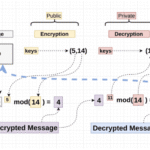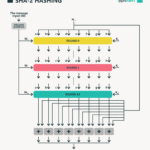In the ever-evolving world of cryptography, the tools and techniques utilized to protect sensitive data are continually subjected to scrutiny and revision. Amid the onslaught of new encryption methodologies, Triple DES (3DES) originally stood as a formidable guardian of information. However, as the digital landscape has matured, it has become increasingly evident that this once-celebrated encryption standard is no longer regarded as the cool kid on the block. The trajectory of 3DES is indeed a tale of innovation evolving into obsolescence, driven by advancements in computational power and shifting security requirements.
To fully comprehend the decline of Triple DES, we must first delve into its origins. Triple DES emerged in the late 1970s, derived from the original Data Encryption Standard (DES), which essentially employed a block cipher methodology. Initially, pertinent cryptographic elements utilized 56-bit keys, which were deemed sufficient at the time. However, with burgeoning computational capabilities, the encryption community recognized the vulnerability of such a key length to brute-force attacks. To counteract this, the 3DES implementation utilized a strategy of applying the DES algorithm three times—effectively multiplying the key length to 168 bits. This innovative approach flattered to deceive, as it was designed to bolster security against increasingly potent adversaries.
Nonetheless, while 3DES fortified defenses, it also introduced a plethora of inefficiencies. The triplet application of the DES algorithm inherently slowed performance, necessitating considerably more processing power and time compared to its forebear. In an age where speed and efficiency are paramount—particularly with the rise of real-time communications and instant transactions—such latency became a significant detriment. Organizations began to find the trade-off between security and performance increasingly untenable, leading to the search for alternatives that promised both robust encryption and swifter execution.
One of the most critical areas where 3DES faltered concerns its susceptibility to various cryptographic attacks. Despite its enhanced complexity, researchers demonstrated vulnerabilities inherent within its structure. Notably, the relatively tedious process of applying DES multiple times did not fundamentally change the algorithm’s structural weaknesses. In particular, the meet-in-the-middle attacks and the fact that the key-scheduling algorithm remained constant across the applications rendered it significantly less resistant to attacks than initially anticipated. As the cryptanalytical landscape further advanced, the fingerprints of weakness became glaringly apparent.
In addition, the advent of modern cryptographic protocols has underscored 3DES’s limitations. As organizations transitioned to the internet—and with it, the proliferation of sophisticated threats—the demand for encryption schemes that not only provide confidentiality but also integrity and authenticity became imperative. In this framework, more contemporary algorithms like the Advanced Encryption Standard (AES) seized the initiative. AES, with its dynamic key lengths—ranging from 128 to 256 bits—promised unparalleled security while excelling in performance benchmarks. Organizations quickly embraced AES, heralding a new era in encryption technology.
The conversation surrounding 3DES cannot ignore the significant strides made in quantum computing. Proposed advancements in this field threaten to upend traditional cryptographic mechanisms entirely. As it stands, 3DES operates on principles that could be rendered obsolete by quantum algorithms capable of decrypting classical encryption methods with alarming efficiency. The ramifications of such advancements urge cryptographers and organizations alike to eschew dated systems for more future-proof alternatives.
This is not to suggest that 3DES was an inadequate system during its heyday. On the contrary, its implementation in various applications, including virtual private networks (VPNs) and secure file transfers, provided a security backbone that many relied upon. However, the passage of time, combined with the inexorable progression of computational technology, exposed critical shortcomings. Embracing stronger alternatives has become imperative in the face of relentless cyber threats.
While the industry consensus has largely shifted toward AES and other state-of-the-art algorithms, it is essential to appreciate the pivotal role that 3DES played in shaping modern cryptography. Its legacy lives on, providing foundational principles and fostering an understanding of encryption’s vital importance in safeguarding sensitive information. However, with the stark realities of today’s threats and the sophistication of attackers, continuing to employ 3DES as a primary encryption method could be tantamount to inviting disaster.
In conclusion, the decline of Triple DES serves as a case study in the relentless march of technology, illustrating how even the most celebrated methods can fall from favor. Its journey from a once-coveted encryption technique to a deprecated format exemplifies the necessity for continual evolution within cryptography. As cyber threats become ever more sophisticated, so too must our defenses. To remain vigilant and secure, the cryptographic community must prioritize robust methodologies, ensuring the data’s ultimate protection in an increasingly perilous digital landscape. The future lies in embracing innovations that not only guard our information but also adapt seamlessly as the realm of cryptography evolves.









Leave a Comment